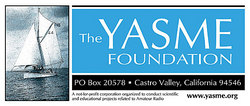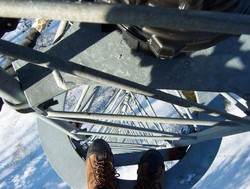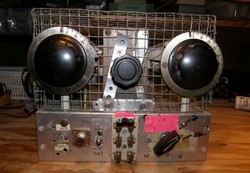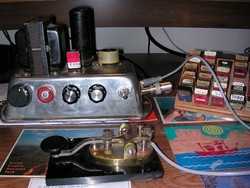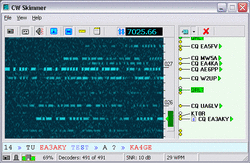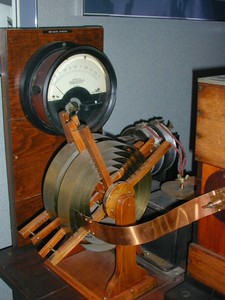 January 5, 2011 Editor: Ward Silver, NØAX | |||||||||
IN THIS ISSUE
NEW HF OPERATORS - THINGS TO DO I can't think of a better pair of contests for the beginning radiosporter than the North American QSO Party CW and SSB events - just give your name and state! If you'd rather type, try the ARRL's RTTY Roundup instead. BULLETINS See the News and Results items regarding scoring and multiplier log format for this and next weekend's North American QSO Party contests. BUSTED QSOS No errors detected or corrected! CONTEST SUMMARY Complete information for all contests follows the Conversation section Jan 8-9
Jan 15-16
NEWS, PRESS RELEASES, AND GENERAL INTEREST
The YASME Excellence Awards are given to individuals who through their own service, creativity, effort and dedication have made a significant contribution to the cause of Amateur Radio. The contribution may be in recognition of technical, operating, or organizational achievement as all three are necessary for amateur radio to grow and prosper. With the 2010 Excellence Awards, YASME recognizes the following individuals in order to recognize them and inspire others on behalf of Amateur Radio now and in the future.
There has been some confusion about logging for the upcoming NAQP CW and SSB contests regarding what is an acceptable abbreviation for North American countries. Contest manager, Bruce WA7BNM clarifies the situation as follows: "For US states and Canadian provinces and territories, use standard postal abbreviations as the QTH designations. For North American countries, other than the US and Canada, use the standard ARRL DXCC entity prefixes as the QTH designations. Other abbreviations are acceptable as long as they unambiguously designate the QTH. The logged QSO info for contacts with stations outside of North America may leave the QTH blank, or specify "DX", in lieu of the country designation. This and other logging suggestions that are designed to reduce errors in entrants' submitted logs are described on the NCJ web site. Participants are responsible for assuring that they have recorded this information correctly in the logs before they submit them regardless of the logging software they are using." Bruce continues regarding the use of decoding technology in the contest's Single-Op category, "We've returned the Single-Op criteria to the pre-2009 definition that prohibits the use of automated tools. The rules on the NCJ web site have been updated to reflect this change." The World Wide Radio Operators Foundation, Inc. (WWROF) has been granted IRS 501(c)3 status as a tax-exempt public charity. This means that contributions to WWROF by U.S. taxpayers are deductible to the extent allowed by law. Two new directors were also added; John Sluymer, VE3EJ, and Tine Brajnik, S5ØA, both well-known in the international contest community for their operating skill and leadership talents. In the past year, WWROF has provided financial and "behind-the-scenes" technical support for several programs of interest to active operators, including several award programs and log-checking services for the IARU HF Championship HQ station competition. In 2011, WWROF will be seeking to implement several high-impact, high-return programs that will benefit the contest community at large and would appreciate your financial support.
Tor N4OGW announces the release of a new logging program, SO2SDR. "The general idea is to explore uses of SDR technology for SO2R (Single-op, Two-radio) CW contesting." The program does not decode any CW and is freely available for download. Tor notes that it is still a work in progress, but does run on both Windows and Linux platforms and features an SDR panadapter integrated into the band map. The 22nd annual Dayton TopBand Dinner is slated for Friday night, May 20, 2011 at the Crowne Plaza Hotel. Program details and menu selections will be announced in late January and tickets will be available starting in February. (Thanks, Tim K3LR) Rin JG1VGX contributes new of the Japanese digital band plan just in time for this weekend's ARRL RTTY Roundup contest. Summarizing, most JA stations will be found here: The LZ Open Contest is trying a new score reporting technique according to Krasimir LZ1GL. "You can watch live logs check right after the contest after every new log received and uploaded. You can also compare your log with any other log and you can see your errors. This cross check function is unique and we are proud to be the first contesters using it." The contest will also be recorded from Sofia, Bulgaria. A similar tactic is being employed by the sponsors of the Montana QSO Party. "After the contest is over, upload your scores and logs and see the results instantly! You will also be able to download a 2011 Montana QSO party certificate that you can print out in full color!" (Thanks, Lyndell N7LT, Montana QSO Party Manager) Web Site of the Week - The latest issue of the Finnish contesting magazine Pileup!, is online and ready for your reading enjoyment. It's a "wonderful, fantastic reading, great job! Thank you," according to contester Jim, K1TN. WORD TO THE WISE Can this be the first set of contest disqualification rules? "For in a contest there is much labor needed--and after the contest victory falls to some, to others disgrace. Is the palm ever given or the crown granted before the course is finished? ... Therefore no one can receive a reward, unless he has striven lawfully; nor is the victory a glorious one, unless the contest also has been toilsome." -St. Ambrose of Milan, Chapter 15, Three Books on the Duties of the Clergy, 4th century (Thanks, Bert N4CW via John K1AR) We're still having fun "using a few verticals on the beach..." reports Kenny K2KW/C6ATA regarding the Team Vertical trip during the 2010 CQWWCW. You'll particularly enjoy the unorthodox mounting of the 160 meter vertical. "Weather and waves prohibited us from installing 160m vertical in one piece. After a lot of thought and computer analysis, we came up with a unique solution: put the base of the vertical on the beach, and the rest of the antenna on the elevated deck of the villa. While not graceful, the 160 sure worked as N6BT has claimed a new 160m LP World Record. We hope you enjoy the videos and photos which review the antenna & station design."
The big signals from Vlad RA4LW will be off the air for a while due to a recent snow and ice storm in Russia. The antenna farm damage was severe as shown by gallery images 798 through 808. RD3A also suffered a lot of damage in the same storm. (Thanks, Yuri VE3DZ and Al 4L5A) Speaking of digital modes...and what is that sound anyway? You can take an online tour of the audio signal signatures courtesy of WB8NUT. (Thanks, George K5TR) Log checking issues with the Summer 2010 NAQP contests have resulted in the contests being rescored. "NAQP management has made the decision because of some conflicting information on the Web as to the correct way to log non W/VE North American stations in NAQP. As a result, a popularly used logging program was incorrectly populating the QTH field for non W/VE North American stations. This caused a number of QSOs and multipliers to be disallowed in participant's logs. Rescoring these events did not change any of the top finishers in the SSB or RTTY NAQP. However, this rescoring did change the Top Ten finish order for several stations in the Top Ten Single Operator class of the August 2010 CW NAQP including a change in the overall winner. The revised results are available on the NCJ Web site under Preliminary Results and will be summarized in the Mar/Apr, 2010 issue of NCJ." (Thanks, NCJ Editor, Al K0AD) The results for the 2010 CW Rookie Roundup are now posted. Award certificates will be emailed to Rookie participants within the next several days. Mark your calendars for Sunday, April 17, 2011 for the Next Rookie Roundup; April will feature SSB, and anybody licensed in 2009, 2010 or 2011 can enter as a Rookie. (Thanks, ARRL Contest Branch Manager, Sean KX9X) The results for the 2010 CQ 160 Meter Contest are now available online. There are some corrections to the article:
To get your Log Checking Report, email CQ WW 160 Contest Director, Andy N2NT indicating your call sign and mode. CQ WPX Contest Director, Randy K5ZD announces that, "Following in the established footsteps of the CQWW Contest, the CQ WPX Contest is now making submitted logs public and available for download. The first contest to be posted is WPX SSB 2010. Read the WPX blog for more information."
A listing of the preliminary results of the 2010 Stew Perry contest is online with 630 logs submitted thus far. (Thanks, Stew Perry Contest Manager, Tree N6TR) The results of the 2010 Ukrainian DX Contest are now online. (Thanks and Happy New Year from Leon, UT7CL) Marc ON7SS/OO9O has posted the 2010 UBA CW Contest results online, as well. The Contest Certificate database is also up to date so you can download your certificate. Like "shooting your age" in golf, Jack W1WEF reports, "In 2010, my 58th year as a ham, I set a goal to operate in 58 contests. RAEM wrapped it up!" OPERATING TIP In RTTY contests, do not use "cut numbers", such as 5NN. This requires an extra shift character to be sent, making your rate slower, unlike CW. Also note that if you receive a letter sequence where numerals are expected, the shift character was likely miscopied. The number represented by each letter is above and to the left of the letter key. For example, TOO is 599 without the shift. (Thanks, Dick WØRAA and Barry W2UP) The mail carrier brought me the February 2011 issue of "Sky and Telescope" and its theme is the ham's favorite star - the Sun. The lead story is on the giant solar storm of 1859 and what the effects of such as storm today might be. Plus, there are loads of solar photos and "Amateur Solar Radio Astronomy", a great article on how to listen to the Sun at wavelengths from 10 meters to 1 cm. If you do pick up an issue, be sure to flip to the back page's "Focal Point" on demonstrating astronomy - it might give you some ideas about putting ham radio in the public's eye, as well. Speaking of solar flares, last May the Galaxy 15 communications satellite had its "brains fried" (a technical term) by just such an event. Although still functional, its navigation and communications systems would not accept commands and the satellite drifted out of its orbit. On December 23, engineers at Intelsat were finally able to reset the satellite and it was put into safe mode. (From AMSAT bulletin ANS-002.07) A pair of eham.net technical articles caught my eye and may give you some ideas, too. The first is for every little pistol's dream - a 40 meter beam. The article "Vertical Moxon for 40 Meters" by N8MUS describes hanging a vertical wire beam antenna under a KT34A tribander. The second article is a classic by one of the site's founders - "Fighting CC&R's: 20M 4-Square Array" by W4AN (SK). It shows how to make the best of a compromise situation and still have a useful and capable antenna system.
Everybody needs a miniature solder pot now and then and here is the Goldilocks version - it's "just right". (Thanks, Dan KI4YZE) Successful RFI sleuthing often takes a bit of the deerstalker hat and meerschaum pipe as in these "The Case of..." RFI stories by ON4WW. (Thanks, Tim K3LR) I debated whether to put this video of a 190-foot tower going up under Sights and Sounds, but as it provides some heavy-duty guidelines for heavy-duty towers, it's a Technical Tip. (Thanks, Craig K9CT) David K1TTT writes to let us know, "I have just cut the prices on my 25th Anniversary edition of "Building a Super Station". The e-book download is now free, and the DVD and paper copies are $5 cheaper than before." Instead of soldering aluminum wire, trying splicing as described by Tod, KØTO. "Wrap 5 turns of aluminum wire tightly around the second aluminum wire and wrap 5 turns of the second wire around the first wire about 3 inches away from the first splice wrap. The result is a very satisfactory splice between the wires." Tod recommends stainless steels fasteners to clamp the wires. Technical Web Site of the Week - This week features a long list of web sites offering SDR kits for receivers and transceivers thanks to Ken K9VV. Enjoy! www.sdr-cube.com/ (Transceiver) From Parallel to Series and Back Again The recent discussions about single-operator categories in the NAQP and many other contests are a microcosm of the larger technological hurricane rearranging the wireless world and with it, Amateur Radio. Since the invention of the tuned amplifier, the radio spectrum has been envisioned as a "series circuit" so that one tunes through individual signals sequentially by frequency, just as current flows through the components of a series circuit.
Everything about the box called a "radio" supports this concept. Our frequency displays and dials assign a different value to each frequency, sometimes around a circle or across a scale. Stacks of increasingly narrow filters carefully select just a single signal out of all that are present. Incremental tuning, passband shift, high-cut, low-cut, notch, split - these are all devices to navigate us in the frequency-domain world. It's as if our radio world was a one-dimensional string that stretches from dc to light and beyond, with each station a separate bead on the string. It's safe to say that nearly all contest operators learned to contest and developed their skills based on the series model of radio. Most of us are very heavily invested in that model. We pride ourselves on being able to tune from bead to bead quickly. In a dense region of beads, we can distinguish between them accurately and rapidly. We develop a sense of when to stay put or move along the string and of where more beads can be found. Similarly, nearly all contests are set up with the series model underlying their rules, categories, scoring, and awards. We are limited in how and where our bead can be placed. Information about the position and behavior of other beads is strictly limited. With the advent of wideband signal processing software and the availability of hardware to make it feasible in amateur stations, the model is changing. Instead of a series spectrum, it is commonplace to view wide swaths of spectrum - and the signals in it - in parallel, all at once. The information in those signals is available all at once and to all. What was previously hidden in the series world is public in the parallel world. This is a seismic shift in the world of radiosport.
What happens to the series version of radiosport and of ham radio in general as radio changes from series to parallel? Is it necessary to possess the series skill set in order to excel in the parallel world? Or does the parallel world require a whole new and different set of skills that have no analog in the series environment. How can a series contester adapt to and excel in a parallel world? For many of us, this transition will be uncomfortable. There is precedent elsewhere in the wireless community. Beginning over a decade ago, the cellular telephone industry began its changeover from the series format of FDMA (frequency-division, multiple-access) model of channels with separate frequencies. The new parallel model is based on CDMA (code-division, multiple-access) in which signals used the same spectrum simultaneously, but are differentiated based on coded patterns of behavior - i.e. spread-spectrum techniques. Was all of the old FDMA knowledge obsolete? Not hardly. Much of the fundamental physical know-how required to create, modulate, transmit, receive, and demodulate RF signals is equally applicable to both worlds. Once the information has been recovered, the processes of handling and routing information are nearly independent of how the actual transmission and reception were performed. So the transition is survivable - even though occasionally painful or disconcerting - if one can distinguish between the key principles that are meaningful in both worlds. It may mean moving beyond some of the hard-won skills of a different era, but if there are sufficient common elements we will be able to recognize the signposts and move confidently into the future.
The careful reader may have noted that the title of this column refers to a pair of transitions and begins with "parallel", not "series". I've only addressed the second transition so far, but I want to remind the readers that the original wireless environment was very much a parallel world. Emissions from spark transmitters are wideband by nature and with the feeble selectivity of early receivers wireless technology was a thoroughly "spread spectrum" endeavor. Techniques such as rotary spark gaps performed rudimentary amplitude modulation, giving signals some individuality. Even an individual's "fist" served as a means of picking one signal out of the QRN and QRM. Every signal was in the mix of noise in the headphones. With the widespread adoption of continuous wave came the transition to our modern series world and, yes, proponents of spark decried the change. But they found many of their techniques and skills to have meaning in the new world, too. While oiling the rotary's bearings was no longer of much use, the skill of putting up an effective aerial was just as important, if not more so for the new QRP CW transmitters. Translating to the present day, while our VFO tuning skills may atrophy with the advent of wideband SDR and DSP, it will still be just as important to know the most effective heights for a beam, how to deal with "rotten QRM", and keep our competitive butts in the operating chair. Plus, there will be new skills to learn. The next challenge to address and the subject of the next issue's Conversation will be of where the operator stops and where the station begins. Technology is blurring that line as well, yet the question may yield if one can remember to shift focus between principle and gadget and back again. 5 Jan to 18 Jan 2011 An expanded, downloadable version of QST's Contest Corral in PDF format is available. Check the sponsor's Web site for information on operating time restrictions and other instructions. HF CONTESTS NS Weekly Sprint--CW, from Jan 7, 0230Z to Jan 7, 0300Z. Bands (MHz): 1.8-14. Frequencies: Weekly on Thursday evenings local time. Exchange: Serial, name, and S/P/C. Logs due: 2 days. Rules 070 PSKFest--Digital, from Jan 8, 0000Z to Jan 8, 2400Z. Bands (MHz): 3.5-28. Exchange: Call sign, RST, S/P/C . Logs due: Feb 8. Rules Hunting Lions In the Air--Phone,CW,Digital, from Jan 8, 0000Z to Jan 9, 2359Z. Bands (MHz): 1.8-28. Exchange: RS(T), serial or name, club name, district. Logs due: Feb 28. Rules WW Peace Messenger Cities--Phone,CW, from Jan 8, 1200Z to Jan 9, 1200Z. Bands (MHz): 1.8-28. Exchange: RS(T) and PMC ref number or CQ zone. Logs due: 30 days. Rules ARRL RTTY Roundup--Digital, from Jan 8, 1800Z to Jan 9, 2400Z. Bands (MHz): 3.5-28. Exchange: RST, state/province/serial. Logs due: Feb 1. Rules North American QSO Party--CW, from Jan 8, 1800Z to Jan 9, 0600Z. Bands (MHz): 1.8-28. Exchange: Name and S/P/C. Logs due: 14 days. Rules EUCW 160 Meter Contest--CW, from Jan 8, 2000Z to Jan 8, 2300Z and Jan 9, 0400Z to Jan 9, 0700Z. Bands (MHz): 1.8. Frequencies: Multiple operating periods. Exchange: RST, serial, club name, member nr or "NR". Logs due: Feb 15. Rules DARC 10 Meter Contest--Phone,CW, from Jan 9, 0900Z to Jan 9, 1059Z. Bands (MHz): 28. Exchange: RS(T), serial, DOK code. Logs due: 3 weeks. Rules Midwinter QSO Party--Phone,CW, from Jan 9, 1000Z to Jan 9, 1400Z. Bands (MHz): 3.5-28. Exchange: RS(T) and serial. Logs due: Feb 15. Rules CWops Mini-CWT Test--CW, from Jan 12, 1100Z to Jan 13, 0400Z, Monthly on the second Wednesday, multiple operating periods - see Web site. Bands (MHz): 3.5-14. Frequencies:, 18 to 28 kHz above band edge. Exchange: Name and member number or S/P/C. Logs due: 2 days. Rules Linc Cundall Memorial CW Contest--CW, from Jan 12, 2300Z to Jan 13, 2300Z and Jan 15, 2300Z to Jan 16, 2300Z. Bands (MHz): 1.8-7. Multiple operating periods. Exchange: See Web site. Logs due: 30 days. Rules LZ Open Contest--CW, from Jan 15, 0000Z to Jan 15, 0400Z. Bands (MHz): 3.5, 7. Exchange: 6-digit serial and serial from previous QSO. Logs due: 30 days. Rules International United Teenager Contest--Phone,CW, from Jan 15, 0600Z to Jan 15, 1400Z. Bands (MHz): 3.5-28, 144/432/1.2G. Exchange: RS(T) and age or "RT". Logs due: 30 days. Rules UK DX RTTY Contest--Digital, from Jan 15, 1200Z to Jan 16, 1200Z. Bands (MHz): 3.5-28. Exchange: RST and serial. Logs due: 30 days. Rules HA DX Contest--Phone,CW, from Jan 15, 1200Z to Jan 16, 1200Z. Bands (MHz): 1.8-28. Exchange: RS(T) and serial. Logs due: 30 days. Rules Feld-Hell Gridloc Sprint--Digital, from Jan 15, 1600Z to Jan 15, 1800Z. Bands (MHz): 1.8-28. Frequencies: Monthly on 3rd Saturday. Exchange: RST, QTH, Feld-Hell number. Rules North American QSO Party--Phone, from Jan 15, 1800Z to Jan 16, 0600Z. Bands (MHz): 1.8-28. Exchange: Name and S/P/C. Logs due: 14 days. Rules VHF+ CONTESTS International United Teenager Contest--Phone,CW, from Jan 15, 0600Z to Jan 15, 1400Z. Bands (MHz): 3.5-28, 144/432/1.2G. Exchange: RS(T) and age or "RT". Logs due: 30 days. Rules LOG DUE DATES 5 Jan to 18 Jan 2011 January 6 ARS Spartan Sprint January 7 AGB-Party Contest January 9 AWA Bruce Kelley Memorial CW Contest January 10 DARC Christmas Contest January 10 RSGB 80m Club Championship, CW January 11 ARRL 10-Meter Contest January 11 CQC Great Colorado Snowshoe Run January 15 NA High Speed Meteor Scatter Winter Rally January 15 OK DX RTTY Contest January 15 ARCI Pet Rock Celebration January 17 AGCW VHF/UHF Contest January 18 Croatian CW Contest January 18 Russian 160-Meter Contest ARRL Information Click here to advertise in this newsletter. Your One-Stop Resource for Amateur Radio News and Information ARRL membership includes QST, Amateur Radio's most popular and informative journal, delivered to your mailbox each month. Subscribe to NCJ - the National Contest Journal. Published bimonthly, features articles by top contesters, letters, hints, statistics, scores, NA Sprint and QSO Parties. Subscribe to QEX - A Forum for Communications Experimenters. Published bimonthly, features technical articles, construction projects, columns and other items of interest to radio amateurs and communications professionals. Free of charge to ARRL members: Subscribe to The ARRL Letter (weekly digest of news and information), the ARES E-Letter (monthly public service and emergency communications news), Division and Section news -- and much more! ARRL offers a wide array of products to enhance your enjoyment of Amateur Radio. Visit the site often for new publications, specials and sales. Donate to the fund of your choice -- support programs not funded by member dues! ACKNOWLEDGEMENTS ARRL Contest Update wishes to acknowledge information from WA7BNM's Contest Calendar and SM3CER's Contest Calendar. | |||||||||
